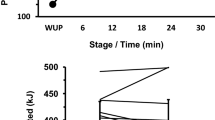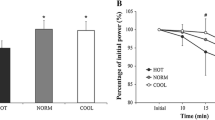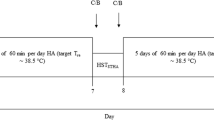Abstract
The capacity to perform exercise is reduced in a hot environment when compared to cooler conditions. A limiting factor appears to be a higher core body temperature (T core) and it has been suggested that an elevated T core reduces the drive to exercise, this being reflected in higher ratings of perceived exertion (RPE). The purpose of the present study was to determine whether passive heating to increase T core would have a detrimental effect on RPE and thermal comfort during subsequent exercise in the heat and whether head-cooling during passive heating would attenuate these unpleasant sensations of an elevated T core during subsequent exercise in the heat. Nine physically-active, non-heat-acclimated volunteers [6 males, 3 females; age: 21 ± 1 year, \( \ifmmode\expandafter\dot\else\expandafter\.\fi{V}{\text{O}}_{{{\text{2max}}}} : \) 50 ± 9 ml kg−1·min−1, peak power output: 286 ± 43 W (mean ± SD)] performed two 12-minute constant-load cycling tests at 70% \( \ifmmode\expandafter\dot\else\expandafter\.\fi{V}{\text{O}}_{{{\text{2max}}}} \) in a warm-dry environment (34 ± 1°C, relative humidity <30%) separated by a period of passive heating in a sauna (68 ± 3°C) to increase T core. In one trial, subjects had their head and face cooled continually in the sauna (HC), the other trial was a control (CON). Passive heating increased T core by 1.22 ± 0.03°C in the CON and by 0.75 ± 0.07°C in the HC trial (P < 0.01). Passive heating increased weighted mean skin temperature (T msk) in both the CON and HC trials (P < 0.01), however, head-cooling lowered T msk during passive heating (P < 0.05). Exercise time following passive heating was reduced in both the CON and HC trials (P < 0.05). Passive heating increased RPE (P < 0.01), however, RPE was lower following passive heating with head-cooling (P < 0.05). There was a significant correlation between T core and RPE (r = 0.82, P < 0.001). In conclusion, our results suggest increased RPE during exercise in the heat is primarily due to the increase in T core. Furthermore, head-cooling attenuates the rise in T core and the effect on RPE is proportional to the rise on T core.



Similar content being viewed by others
References
Armada-da-Silva PA, Woods J, Jones DA (2004) The effect of passive heating and face cooling on perceived exertion during exercise in the heat. Eur J Appl Physiol 91:563–571
Borg G (1982) Psychophysical bases of perceived exertion. Med Sci Sports Exerc 14:377–381
Brown GA, Williams GM (1982) The effect of head cooling on deep body temperature and thermal comfort in man. Aviat Space Environ Med 53:583–586
Brück K, Olschewski H (1987) Body temperature related factors diminishing the drive to exercise. Can J Physiol Pharmacol 65:1274–1280
Cheung SS, McLellan TM (1998) Heat acclimation, aerobic fitness, and hydration effects on tolerance during uncompensable heat stress. J Appl Physiol 84:1731–1739
Cotter JD, Taylor NA (2005) The distribution of cutaneous sudomotor and alliesthesial thermosensitivity in mildly heat-stressed humans: an open-loop approach. J Physiol 565:335–345
Crawshaw LI, Nadel ER, Stolwijk JAJ (1975) Effect of local cooling on sweating rate and cold sensation. Pflugers Arch 354:19–27
Dill DB, Edwards HT, Bauer PS, Levenson EJ (1931) Physical performance in relation to external temperature. Eur J Appl Physiol 4:508–518
Febbraio MA, Snow RJ, Stathis CG, Hargreaves M, Carey MF (1994) Effect of heat stress on muscle energy metabolism during exercise. J Appl Physiol 77:2827–2831
Fox RH, Goldsmith HR, Kidd DJ (1962) Cutaneous vasomotor control in the human head, neck and upper chest. J Physiol 161:298–312
Frank SM, Raja SN, Bulcao CF, Goldstein DS (1999) Relative contribution of core and cutaneous temperatures to thermal comfort and autonomic responses in humans. J Appl Physiol 86:1588–1593
Gagge AP, Stolwijk JA, Hardy JD (1967) Comfort and thermal sensations and associated physiological responses at various ambient temperatures. Environ Res 1:1–20
Galloway SD, Maughan RJ (1997) Effects of ambient temperature on the capacity to perform prolonged cycle exercise in man. Med Sci Sports Exerc 29:1240–1249
Gonzàlez-Alonso J, Calbet JA, Nielsen B (1998a) Muscle blood flow is reduced with dehydration during prolonged exercise in humans. J Physiol 513:895–905
Gonzàlez-Alonso J (1998b) Separate and combined influences of dehydration and hyperthermia on cardiovascular responses to exercise. Int J Sports Med 19:S111–S114
Gonzàlez-Alonso J, Teller C, Andersen SL, Jensen FB, Hyldig T, Nielsen B (1999) Influence of body temperature on the development of fatigue during prolonged exercise in the heat. J Appl Physiol 86:1032–1039
Hertzman AB, Roth LW (1942) The absence of vasoconstrictor reflexes in the forehead circulation. Effects of cold. Am J Physiol 136:692–697
Kuipers H, Verstappen FT, Keizer HA, Geurtem P, van Kranenburg G (1985) Variability of aerobic performance in the laboratory and its physiologic correlates. Int J Sports Med 6:197–201
MacDougall JD, Reddan WG, Layton CR, Dempsey JA (1974) Effects of metabolic hyperthermia on performance during heavy prolonged exercise. J Appl Physiol 36:538–544
Maw GJ, Boutcher SH, Taylor NA (1993) Ratings of perceived exertion and affect in hot and cool environments. Eur J Appl Physiol Occup Physiol 67:174–179
Morrison S, Sleivert GG, Cheung SS (2004) Passive hyperthermia reduces voluntary activation and isometric force production. Eur J Appl Physiol 91:729–736
Mündel T, Hooper PL, Bunn SJ, Jones DA (2006) The effects of face cooling on the prolactin response and subjective comfort during moderate passive heating in humans. Exp Physiol 91:1007–1014
Mündel T, Bunn SJ, Hooper PL, Jones DA (2007) The effects of face cooling during hyperthermic exercise in man: evidence for an integrated thermal, neuroendocrine and behavioural response. Exp Physiol 92:187–195
Nielsen R, Nielsen B (1984) Measurement of mean skin temperature of clothed persons in cool environments. Eur J Appl Physiol Occup Physiol 53:231–236
Nielsen B, Hales JR, Strange S, Christensen NJ, Warberg J, Saltin B (1993) Human circulatory and thermoregulatory adaptations with heat acclimation and exercise in a hot, dry environment. J Physiol 460:467–485
Nielsen B, Hyldig T, Bidstrup F, Gonzàlez-Alonso J, Christoffersen GR (2001) Brain activity and fatigue during prolonged exercise in the heat. Pflugers Arch 442:41–48
Nunneley SA, Reader DC, Maldonado RJ (1982) Head-temperature effects on physiology, comfort and performance during hyperthermia. Aviat Space Environ Med 53:623–628
Nunneley SA, Maldonado RJ (1983) Head and/or torso cooling during simulated cockpit heat stress. Aviat Space Environ Med 54:496–499
Nybo L, Nielsen B (2001a) Perceived exertion is associated with an altered brain activity during exercise with progressive hyperthermia. J Appl Physiol 91:2017–2023
Nybo L, Nielsen B (2001b). Hyperthermia and central fatigue during prolonged exercise in humans. J Appl Physiol 91:1055–1060
Pitsiladis YP, Maughan RJ (1999) The effects of exercise and diet manipulation on the capacity to perform prolonged exercise in the heat and in the cold in trained humans. J Physiol 517:919–930
Todd G, Butler JE, Taylor JL, Gandevia SC (2005) Hyperthermia: a failure of the motor cortex and the muscle. J Physiol 563:621–631
Author information
Authors and Affiliations
Corresponding author
Rights and permissions
About this article
Cite this article
Simmons, S.E., Mündel, T. & Jones, D.A. The effects of passive heating and head-cooling on perception of exercise in the heat. Eur J Appl Physiol 104, 281–288 (2008). https://doi.org/10.1007/s00421-007-0652-z
Accepted:
Published:
Issue Date:
DOI: https://doi.org/10.1007/s00421-007-0652-z




